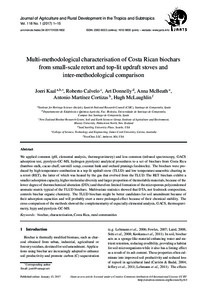Datum
2017-01-13Autor
Kaal, JoeriCalvelo, RobertoDonnelly, ArtMcBeath, AnnaMartínez Cortizas, AntonioMcLaughlin, HughSchlagwort
630 Landwirtschaft, VeterinärmedizinMetadata
Zur Langanzeige
Aufsatz

Multi-methodological characterisation of Costa Rican biochars from small-scale retort and top-lit updraft stoves and inter-methodological comparison
Zusammenfassung
We applied common (pH, elemental analysis, thermogravimetry) and less-common (infrared spectroscopy, GACS adsorption test, pyrolysis-GC-MS, hydrogen pyrolysis) analytical procedures to a set of biochars from Costa Rica (bamboo stalk, cacao chaff, sawmill scrap, coconut husk and orchard prunings feedstocks). The biochars were produced by high temperature combustion in a top-lit updraft stove (TLUD) and low temperature anaerobic charring in a retort (RET), the latter of which was heated by the gas that evolved from the TLUD. The RET biochars exhibit a smaller adsorption capacity, higher molecular diversity and larger proportion of thermolabile materials, because of the lower degree of thermochemical alteration (DTA) and therefore limited formation of the microporous polycondensed aromatic matrix typical of the TLUD biochars. Multivariate statistics showed that DTA, not feedstock composition, controls biochar organic chemistry. The TLUD biochars might be better candidates for soil amendment because of their adsorption capacities and will probably exert a more prolonged effect because of their chemical stability. The cross-comparison of the methods showed the complementarity of especially elemental analysis, GACS, thermogravimetry, hypy and pyrolysis-GC-MS.
Zitierform
In: Journal of Agriculture and Rural Development in the Tropics and Subtropics. Kassel : Kassel University Press. - Vol. 118, No. 1 (2017), S. 1-15Sammlung(en)
Vol 118, No 1 (2017) (Journal of Agriculture and Rural Development in the Tropics and Subtropics (JARTS))Zitieren
@article{urn:nbn:de:hebis:34-2017010351802,
author={Kaal, Joeri and Calvelo, Roberto and Donnelly, Art and McBeath, Anna and Martínez Cortizas, Antonio and McLaughlin, Hugh},
title={Multi-methodological characterisation of Costa Rican biochars from small-scale retort and top-lit updraft stoves and inter-methodological comparison},
year={2017}
}
0500 Oax 0501 Text $btxt$2rdacontent 0502 Computermedien $bc$2rdacarrier 1100 2017$n2017 1500 1/eng 2050 ##0##urn:nbn:de:hebis:34-2017010351802 3000 Kaal, Joeri 3010 Calvelo, Roberto 3010 Donnelly, Art 3010 McBeath, Anna 3010 Martínez Cortizas, Antonio 3010 McLaughlin, Hugh 4000 Multi-methodological characterisation of Costa Rican biochars from small-scale retort and top-lit updraft stoves and inter-methodological comparison / Kaal, Joeri 4030 4060 Online-Ressource 4085 ##0##=u http://nbn-resolving.de/urn:nbn:de:hebis:34-2017010351802=x R 4204 \$dAufsatz 4170 7136 ##0##urn:nbn:de:hebis:34-2017010351802
<resource xsi:schemaLocation="http://datacite.org/schema/kernel-2.2 http://schema.datacite.org/meta/kernel-2.2/metadata.xsd"> 2017-03-15T08:00:59Z 2017-03-15T08:00:59Z 2017-01-13 1612-9830 2363-6033 urn:nbn:de:hebis:34-2017010351802 http://hdl.handle.net/123456789/2017010351802 eng Kassel University Press Urheberrechtlich geschützt https://rightsstatements.org/page/InC/1.0/ biochar characterisation Costa Rica rural communities 630 Multi-methodological characterisation of Costa Rican biochars from small-scale retort and top-lit updraft stoves and inter-methodological comparison Aufsatz We applied common (pH, elemental analysis, thermogravimetry) and less-common (infrared spectroscopy, GACS adsorption test, pyrolysis-GC-MS, hydrogen pyrolysis) analytical procedures to a set of biochars from Costa Rica (bamboo stalk, cacao chaff, sawmill scrap, coconut husk and orchard prunings feedstocks). The biochars were produced by high temperature combustion in a top-lit updraft stove (TLUD) and low temperature anaerobic charring in a retort (RET), the latter of which was heated by the gas that evolved from the TLUD. The RET biochars exhibit a smaller adsorption capacity, higher molecular diversity and larger proportion of thermolabile materials, because of the lower degree of thermochemical alteration (DTA) and therefore limited formation of the microporous polycondensed aromatic matrix typical of the TLUD biochars. Multivariate statistics showed that DTA, not feedstock composition, controls biochar organic chemistry. The TLUD biochars might be better candidates for soil amendment because of their adsorption capacities and will probably exert a more prolonged effect because of their chemical stability. The cross-comparison of the methods showed the complementarity of especially elemental analysis, GACS, thermogravimetry, hypy and pyrolysis-GC-MS. open access In: Journal of Agriculture and Rural Development in the Tropics and Subtropics. Kassel : Kassel University Press. - Vol. 118, No. 1 (2017), S. 1-15 Kaal, Joeri Calvelo, Roberto Donnelly, Art McBeath, Anna Martínez Cortizas, Antonio McLaughlin, Hugh Gedruckte Ausg. im Verlag Kassel Univ. Press (www.upress.uni-kassel.de) erschienen. </resource>
Die folgenden Lizenzbestimmungen sind mit dieser Ressource verbunden:
Urheberrechtlich geschützt

